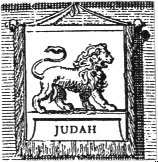
Tribal Standard of Judah
|
|
|
|
|
|
|
|
|
|
|
|
|
|
|
|
|
|
THE STORY
(in brief)
of
Tephi, queen of
Tara and Gibraltar.
(daughter of king
Zedekiah of Jerusalem,
from the line of
king David who slew Goliath)
Teia Tephi became the queen of Ireland on the 21st of June in 583 B.C. and was later wrongfully deified as a mythical goddess called Bo / Bovinda, which is why over the passage of time she became lost in the realms of myth and fantasy, ceasing to be remembered as the real flesh and blood queen, who came to Ireland from Jerusalem, that she really was. She was, like the Irish people, descended from the Jacob who had his name changed by God to Israel at Bethel, where he set up a stone pillar he had used as a pillow, that he anointed with oil and also named Bethel (House of God) along with the place where it happened, as is recorded in the Book of Genesis in the Bible.Jacob-Israel had twelve sons, who fathered the Twelve Tribes of Israel, the fifth of whom was called Dan and he fathered the Tuatha de Danaan (the Tribe of Dan), from whom the Irish and Danish people are descended. The eleventh of Jacob’s twelve sons was called Joseph, to whom Jacob/Israel gave the famous "Coat of Many Colours". Israel’s fourth son, Judah from whom the Jews claim descent and who sold his brother Joseph into slavery in Egypt, had twin sons called Zarah and Pharez, as is recorded in The Old Testament Book of Genesis chapter 38:27-30 of The Holy Bible.
When Judah’s twins were about to be born, the midwife; who knew that there were twins in the womb; had prepared herself with a scarlet cord to mark the firstborn. Today the same thing is done with a plastic name-tag placed around a baby’s wrist. Zarah (meaning ‘Scarlet’ in Hebrew) put his hand out of the womb first and the midwife tied the scarlet cord around his wrist to identify him as the firstborn. He then pulled his hand back into the womb and his twin brother Pharez was born first, thereby breaching his brother Zarah’s birthright and so he was named Pharez which means ‘Breach’ in Hebrew.
Contrary to the commonly-held belief that all Israelites are Jews and before anyone jumps to the wrong conclusion that therefore the Danites are Jews, I must explain that the word Jew and Israelite are not synonymous and do not mean the same or refer to the same people, no matter what your dictionary might say. They refer to two related but different peoples, as any honest and well-informed rabbi. will admit and studying a Bible will confirm.
Long before the birth of Teia Tephi; back in 997 B.C. under David’s grandson Rehoboam, the son of Solomon; the twelve tribes of Israel fell-out with each other and split-up into two separate kingdoms, with two separate kings and they lived side by side but in two separate countries, called Israel and Judaea. The twelve tribes divided into the ten-tribed "House of Israel" who lived in Israel in the northern section of the Holy Land under king Jeroboam and the two-tribed "House of Judah" who lived in Judaea, in the South of the Holy Land, under the sovereignty of Solomon’s son, king Rehoboam.
The Northern kingdom was called Israel and its capital city was Samaria. The Southern kingdom was called Judaea and its capital was Jerusalem. The tribe of Dan was one of the ten tribes of the northern ten-tribed kingdom called Israel and those ten tribes are the same tribes who later became the "Ten Lost Tribes of Israel", so the Danites are therefore Israelites who are not Jewish.
The Jewish people claim their descent from the two-tribed "House of Judah" (Jew-dah), hence their name Jew. All true racial Jews are Israelites but not all Israelites are Jews. Just as, for example, all Scottish people are British but not all of the British people are Scottish.
Returning now to the story; Pharez, having taken the birthright from his brother Zarah, carried the tribal (family) name of Judah, from which came king David, the shepherd boy who slew the giant Goliath with a stone from his sling and became king of Israel. The Royal line of David descends from Pharez and their emblem is an amber/golden lion, rampant, with a crown on its head.
The descendants of his brother, Zarah of the ‘Red Hand’, having lost the Birthright, went into exile and migrated to Heberia (now known as Iberia or Spain). There they built the city of Zaragoza. Zaragoza (originally Zarah-gassa) means the "Stronghold of Zarah" and the city is still called Zaragoza today, even though the Israelites’ traditional enemy, Babylon and Rome, invaded Heberia and drove the Zarahites out to the northern coastlands of Spain. From there many of them fled across the water to Ireland (Hebernia – the Hebrews’ new-land and the Hebrides - Hebrew’s Isles). Some of their descendants migrated from Ireland to Scotland, and, once there, decided to use their own Judah Zarah version of the Judahite emblem, which is the red lion rampant, just as Judah Pharez use the amber lion rampant (rampant is a word used in heraldry. and it means that an animal is shown standing-up on its back legs, on a coat-of-arms).

Tribal Standard of Judah
Centuries after Zarah first left Judaea to go into exile abroad, and the ten-tribed "House of Israel" had been taken out of Israel, the northern kingdom, to Assyria as slaves in 722 B.C., as punishment for breaking The Covenant, Jeremiah the Bible Prophet was sent to king Zedekiah of Jerusalem in the southern kingdom, who had, by then, also broken God’s Covenant, to warn him to return to keeping The Covenant or God would punish the two-tribed "House of Judah", as he had previously punished the ten-tribed "House of Israel". Jeremiah warned king Zedekiah of Jerusalem that, if he did not keep The Covenant, God would send king Nebuchadnezzar of Babylon to lay siege to and destroy Jerusalem. Zedekiah did not like God’s Message so he decided to ignore it and punish God’s messenger by putting him in prison. However that did not prevent the prophecy from being fulfilled, it only made its fulfillment more certain.Nebuchadnezzar sent his army and laid siege to Jerusalem whose inhabitants became so hungry that they ate their own children. The City was not only taken but was also laid-waste and burned. God’s House, the Holy Temple, that had been built for Him by Solomon and Hiram, was also destroyed, along with The City.
Nebuchadnezzar, who was sent by God to punish Zedekiah and the two-tribed "House of Judah"; just as the Assyrians had been used in 722 B.C. to punish the ten-tribed "House of Israel"; honoured Jeremiah as God’s Prophet; released him from prison and gave him free reign to do as he was commanded by God.
Zedekiah, who was descended from the royal line of David of the Pharez branch of the tribe of Judah, and all of his sons were captured and taken from Jerusalem to Babylon, where his sons were slain in front of Zedekiah’s eyes and then he was blinded, so that the execution of his sons would be the last thing he ever saw. He himself died in prison, in Babylon, and all of this was because he betrayed God and his people; broke The Covenant and caused his people to suffer poverty under his own laws, instead of prosperity under God’s Laws in The Covenant that is written in The Torah. The Torah is the collective name for the Five Books given to Israel through Moses at Horeb in Sinai and it means The Law.
The inhabitants of Judaea were also taken captive and were removed from Judaea into Babylon to become slaves to their captors, as punishment for allowing themselves to be misled by their rulers, just as the ten-tribed "House of Israel" had previously been punished and taken off their land Israel, into slavery, before them. The "House of Israel" were taken to Assyria in 722 B.C., from where they never returned home to Israel. The "House of Israel" and the "House of Judah" were both punished for the same reason; that is that they broke The Covenant and allowed their rulers to make up their own poverty-creating selfish laws; economic policies and taxes in contravention of God’s Commandments and prophetical-warnings to His People.
At the time Nebuchadnezzar was king of Babylon, the Assyrians were no longer the world super-power that had defeated the ten-tribed "House of Israel" and had themselves been defeated and driven-out of Assyria, so they were no longer in a position to keep the ten-tribed "House of Israel" as slaves and they all migrated to the North-West of the Holy Land. The Assyrians stopped in what is now called Germany and eventually became the Germans of today with their German Military Cross that is identical to the ancient Assyrian Knight’s Cross.
The ten-tribed "House of Israel" had been slaves in Assyria since 722 B.C. and therefore had learned to speak Assyrian; which is why there are Assyrian (Germanic) words in the English and other North-European languages today. They also lost their Sabbath Sign, that told them who they were, having changed their Sabbath day from the true Sabbath which is the seventh day of the week (Saturday) to the Assyrian and Babylonian Sun-worship religions’ worship-day of Sunday, and so had begun to lose their true history; Mosaic Laws in The Torah and also their identity as Israelites.
Finally being free from domination by the Assyrians, most of the "House of Israel" separated themselves from them and continued on their long trek, to the North-West coastlands and Islands, of what is now Europe, exactly as it was prophesied that they would do.
During the destruction of Jerusalem, by Nebuchadnezzar of Babylon’s troops in 588 B.C., Jeremiah hid with Zedekiah’s daughter Teia Tephi under The Temple, built by Solomon, in a cave where The Ark of The Covenant was hidden along with Jacob’s Pillar (The Bethel/Lia Fail Stone) which is king David’s Throne of Israel.
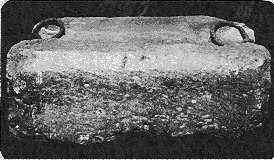
Picture of Bethel / Lia Fail.
The Ark of The Covenant is the special gold box inside of which are kept the original Five Books of The Torah and The Stone Tablets, on which The Ten Commandments were written, that were given to Moses at Horeb in Sinai, for all Israel.
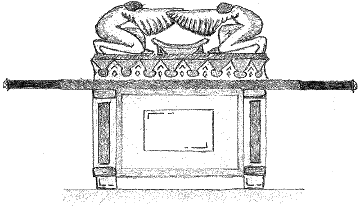
Drawing of The Ark of The Covenant.
Baruch, Jeremiah’s scribe (secretary) then came and told them that the coast was clear, so Jeremiah took Teia Tephi and God’s Treasures and went first to Mizpah and then to Tahpanhes (Tanis) in Egypt for safety. There they stayed in a palace that was given to Teia Tephi by pharaoh Hophra after he adopted her as his own daughter. The palace, although now in ruins at Tel Defneh, is still known today as "Quasr Bint el Jehudi" which means "Palace of the Daughter of Judah", just as she prophesied in her book that it would be.The royal party stayed at Tanis for some time, until Jeremiah was warned by God that Nebuchadnezzar of Babylon was also being sent by Him to invade Egypt and that they must leave, taking The Ark to God’s pre-destined place of safety. Jeremiah’s group left Tanis on a moonless cloudy night, sailing in a ship of Tyre, piloted by a Danite (5th tribe of Israel, known to the Irish as the Tuatha de Danaan) called Buchi son of Helek, who was accompanied by his son Boedan, firstly to Carthage, where they arrived three weeks later, but did not disembark. At sunset a strong hot wind blew from the desert driving them North and tearing their sails. On the seventh day they entered a little bay by the mouth of an unknown river that ran from East to West; where they dropped anchor.
Drawing lots to see who would go ashore to find out where they were, the lot fell upon Boedan, the pilot’s son, who rowed ashore in their skiff. Boedan captured a local and brought him aboard the ship so that Buchi the pilot who spoke all languages could ask him where they were. They found out from him that they were in the Tiber Estuary and he advised them to avoid Rome, both then and throughout the future. Jeremiah made many prophecies about Rome, including about the Roman Crucifixion of Jesus and on up to our day. From there they sailed on between Corsica and Sardinia where Jeremiah prophesied that, in the latter days, Napoleon would unsuccessfully attack Russia.
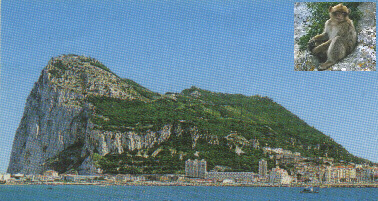
The Rock of Gibraltar.
Jeremiah’s group soon arrived at Gibraltar, the Gate, the Rock with a lion’s shape. There Teia Tephi was proclaimed queen, by the Gadite* Israelites who had settled there and the Rock itself even cried out her name, itself acknowledging her as its queen. Teia found many of the inhabitants worshipping Melcarth / Neptune and condemned them for their idolatry. There was an idol of Neptune at a shrine to him and the idol held a golden trident in its right hand, which Elier the ruler of Gibraltar ordered to be taken from the idol and be given to Teia Tephi to go with the Olive-sprig she had brought with her from Jerusalem. During a struggle with the priests to remove the trident, the idol was smashed in two.* Jeoffry Keating the famous Irish historian called them Gadelians and said that some Gadelians had come to live in Ireland. Curiously there is a Gibstown near to Teltown, Teia’s Tephi’s royal residence and an Irishtown in Gibraltar showing the historical links between Ireland and Gibraltar.
They stayed there for five months and both Teia and Jeremiah made many prophecies about the future of Gibraltar, only one of which still remains to be fulfilled. The crew of the Tyrian ship that brought them to Gibraltar were evil and plotted to kill Jeremiah, Teia Tephi and the others, but three months after their arrival the crew’s evil plot was discovered and foiled, so they left to return to Egypt.
On their way back to Egypt the Tyrian ship sank and there were no survivors, which explains why nobody knew where The Ark went after it left Tanis or even that it had left Tanis. This was confirmed by Baruch who saw a vision of the ship sinking, immediately before his own death, passing away at the age of eighty and being buried at Caer Teia, Gibraltar.
During their stay in Gibraltar The Ark was kept in St. Michael’s Cave in the Rock of Gibraltar. Michael, after whom the cave is named, is the Arch-angel, also known as Christ the Spirit-Being, God’s oldest son, who was incarnated inside the human body called Jesus, two thousand years ago and who Moses was taught by when he sought enlightenment in Michael’s Cave, long before the birth of Jesus, as is recorded in Surah 18 of the Koran. Christ is Prophecied in The Bible; The Koran; The Prophecies of Nostradamus and The Book of Tephi, to, amongst other things, return to Ireland, and; according to the prophecies of Nostradamus; with the soon to be recovered Ark of The Covenant as incontrovertible proof, reveal to the Irish people their true identity as the Israelites that they really are.
Two months after the Tyrian ship had left Gibraltar and sunk, the Gadites’ milesian allies helped Jeremiah’s party by capturing a Greek vessel, which was then sailed with the aid of Simon, the son of Elier the ruler of Gibraltar, guiding them across the Bay of Algeciras and through the Straits to Breogan in Spain, where he introduced them to Ith Cian, the Israelite ruler who, like the Egyptian pharaoh before him, adopted Teia Tephi as his daughter. Ith told them of his missing son called Lughaidh, who had sailed-off several years previously with his five ships and was presumed dead, but, unbeknown to them all, he was living in Ireland, where Teia Tephi and Jeremiah were heading.
When they left Breogan, heading for Ireland, they got caught in a violent storm that lasted seven days and broke the oars and rudder of their boat, so they could not control the direction of their journey. After being blown North for several days in the storm, they sighted land and the wind of the storm (The Hand of God) guided their boat right into the bay at Mara-Zion, near St Michael’s Mount in Cornwall. This was done by God so that they would not land unannounced and unprotected in Ireland. At Mara-Zion they met Elatha the powerful Israelite ruler of Cornwall, who was a kinsman of Ith Cian of Breogan and an ally of Elier bar Ziza of the Gate (Gibraltar). Elatha welcomed them and had their boat repaired for them. He then sent a message to the high king (Ard ri) of Ireland to say that Teia Tephi the queen of Jerusalem was coming and requested a guarantee of safe-passage for the queen.
When Teia Tephi and Jeremiah informed Elatha of the fall of Jerusalem he wept bitterly, so the name given to that place in Cornwall was and still is Mara-Zion, which is Hebrew not Cornish or English and means "Bitter for Jerusalem". Elatha consulted greatly with Jeremiah and was consoled by the knowledge that all of the Promises God made to His "friend" Abraham would be fulfilled, when Christ would come from the Tribe of Joseph / Ephraim and once again reunite all of the twelve tribes of Israel, including the Irish Danites with his kiss.
The Irish kings on receiving Elatha’s message, sent back to him their reply, which was a message of welcome and many gifts of gold and silver to Teia Tephi to show her she would be safe and that they all sought her favour and some her hand in marriage. Eochaidh sent his family’s most treasured heirloom; a piece of jewellery which is called the "Sun of Helen" (of Troy); that his sires had won as a spoil of war at the Battle of Troy, where his Zarahite ancestors and the Danite greek ancestors of the Irish people, including Ulysses, had built their famous Trojan horse, that had successfully fooled the Trojans and gained them access to their city.
After receiving their positive answer and invitation, Elatha sent his son Bressail, who was Nuadh, the king of Ulster’s champion and fifty-three ships, with two thousand and five men, to escort Teia Tephi safely to Ireland. Jeremiah at that point was advised by God to take The Ark of The Covenant in a separate ship and hide. He was warned that there was going to be a rebellion and it was not yet safe to bring The Ark of The Covenant to Tara.
Teia Tephi arrived with the Bethel / Lia Fail Stone and her two handmaidens, at Pen Edair (Binn Eadair - Howth), near Ath Cliath (Dublin), in Ireland on the 18th of June 583 B.C. She was greeted there by Eochaidh, the High king (Ard ri - Heremon) and Ethan, the king’s harper and good friend, between whom she was carried ashore and both instantly fell in love with the queen. Teia Tephi knew only the identity of the harper (Ethan) and didn’t know that the other person carrying her was actually Eochaidh, the High-king, whom she was destined to marry. She stayed that night at the Fort of Crimthann, which was built on the top of Howth Hill.
Eochaidh, who was urgently called away to rescue his sister who had been kidnapped, had, as a child, been given a vision and told that he must not marry, even if he reached middle-age, because one day his queen would come from the East. When he received the message from Elatha, that the queen was coming from Jerusalem to live in Ireland, he realised that his wait was almost over and his boyhood prophetical-vision was about to become reality.
Teia Tephi was then escorted to Cathair Crofinn (The Hill of Tara), where she arrived on the 20th of June in 583 B.C. and was escorted to the house that had already been prepared for her (Rath Grainne - Fort of the Seed) there, over the door of which the Druids had written ‘Jerusalem’, in Hebrew.
At Tara, there were a number of priests of the satanic Baal-religion who had erected a phallic-pillarstone as part of their worship of the mythical gods of pagan Baal fertility. Teia Tephi had brought with her The Torah or God’s Laws, which state that worshipping false gods and making graven images of these, or anything else, is strictly prohibited and carries the death penalty (The Second Commandment), so she ordered that the obscene stone phallus be removed immediately and the Bethel Stone / Lia Fail (God’s Throne of Israel) be put in its place on the Forrad (Inauguration Mound).
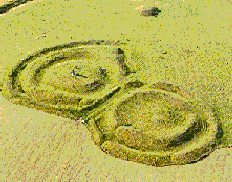
Picture of the Forrad (Inauguration Mound, on left).
The Baal-priests didn’t listen to her at first and left the phallic stone in place. They then decided that they would choose who Teia Tephi was to marry by firing an arrow in the air and whoever’s seat the arrow landed closest to would be the chosen one, who would marry Teia Tephi. To begin with they tried firing arrows from a bow of Baal with no success because of its wild inaccuracy. So it was then decided that The Bow of Strength (Samson’s Bow - Samson was one of their Danite ancestors) should be used instead. Samson’s Bow had three arrows with it, that were far more true. But first they had to find someone strong enough to string the bow, before they could use it. The broadest man on the island was Ethdan, who strained to bend the bow far enough to be able to fit the string, but eventually he succeeded and the string snapped into its groove.Ethdan moved swiftly to the centre of the circle; laid down; placed his feet to the bow and fired the first arrow, which was gold-tipped, into the air and it came down with a ray of bright light hitting the Lia Fail Stone (Bethel Stone - House of God), this indicated that Teia Tephi was to be first and foremost married to God and His Laws in The Torah, humbly serving her people as their queen.
God condemns the divining of issues by the use of arrows, but, in this very important instance, so that His well-laid plans would not be thwarted He interfered with the arrows and made them go where He wanted them to go. Meanwhile Teia was anxiously looking around for the strong but gentle man whom she had instantly felt safe with at Howth, but she couldn’t see him anywhere.
The second arrow they fired had a silver tip and it came down on the seat of Eochaidh the High-king of Ireland, indicating, from God, that Eochaidh was the man that Teia was pre-destined to marry.
Tephi did not know that Eochaidh was the one she was looking for or that this was his seat and nobody said whose seat this was because no-one was sitting on it, so they decided to fire the last of the three arrows with the Bow of Strength, which had a bent shaft and a tip of lead. As they fired the arrow, it spun off to the side twisting like a snake (the serpent - Satan) and hit the phallic Baal-pillar, knocking the gilded horns off it, proving to them that Baal-worship was evil and satanic.
When the people saw what had happened they realised that Teia Tephi’s earlier words were true. and Baal-worship was wrong and evil. So, the Druids repented and took her side against the Baal-priests and they removed the phallic Baal-pillar from the Inauguration Mound (Forrad) and buried it near where Duma na nGiall (Teamur - Tephi’s wall - now known as The Mound of The Hostages) stands today.
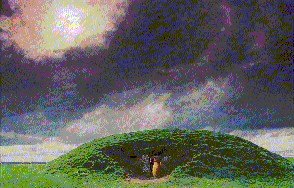
Picture of Duma na nGiall ("Purity of Palms").
Eochaidh the Ard ri (High-king), whose seat the silver arrow had hit, arrived and introduced himself to Teia Tephi. Teia instantly recognised him as the one she had met and fallen in love with at Howth and knew that they were destined to marry, which filled her heart with love; peace and joy. They then gave their pledges of marriage over the Lia Fail / Bethel Stone, and Teia Tephi stood upon the Lia Fail and was acknowledged queen of all Ireland.As Eochaidh was from the Zarah (of the ‘Red Hand’) branch and Teia Tephi was from the line of David of the Pharez branch of Judah, their marriage-union sealed the "breach" caused centuries earlier when Judah’s twin sons had been born. This marriage-union, that took place at "Rath na ri" (the Fort of the kings) at Tara, in Royal Meath, is symbolised on the Ulster flag, where the ‘Red Hand’ of Zarah is mounted upon the ‘Star of David’ under the single Royal Crown, symbolizing the union of the two royal lines, that sprang from Judah.

The Ulster flag.
The phallic Baal-pillar stone that is now wrongfully and blasphemously called the Lia Fail, was re-discovered and placed on The Inauguration Mound at Tara some time between 1839 and 1845.As the real Lia Fail is also known as Bethel, meaning ‘House of God’ in Hebrew and it is prophesied that Christ will come and be Inaugurated King of the Israelites, including the Irish, upon the Lia Fail Stone at Tara, there could be no greater insult to God or Christ than to name a stone phallus The Lia Fail. That is telling God that His House, where He should come and live, is a stone phallus and that Christ should come and sit on a stone penis. The wrongful naming of the obscene phallic stone at Tara caused God’s Cursing of Ireland which brought about the Great Famine of 1845-52 and it is still the "Curse of Tara" and Ireland.
Teia Tephi then began instituting The Torah, or God’s Laws to Ireland. The Torah is perfectly fair and un-biased, uniting everyone, with no rich or poor, all under one system. Under The Torah, nobody can oppress anyone else by inflicting their own selfish opinion or laws and taxes on them, so nobody can put themselves over others (all men were created equal in the eyes of God).
As Ireland, up to that point, had been divided into many individual small kingdoms, each with its own king or warlord who had made up their own laws to make themselves rich, many of these kings and warlords didn’t like The Torah, because under God’s Laws they would have to redistribute the wealth that they had unfairly taken from the people. Then they would become their peoples’ equals, or servants as a true king should be (Deut. 17:14-20), rather than falsely placing themselves above their people making the people slaves to them.
Deuteronomy 17:14 When thou art come unto the land which the "I AM" thy God giveth thee, and shalt possess it, and shalt dwell therein, and shalt say, I will set a king over me, like as all the nations that [are] about me;
17:15 Thou shalt in any wise set [him] king over thee, whom the "I AM" thy God shall choose: [one] from among thy brethren shalt thou set king over thee: thou mayest not set a stranger (a gentile) over thee, which [is] not thy brother.
17:16 But he shall not multiply horses to himself, nor cause the people to return to Egypt (slavery under man-made laws), to the end that he should multiply horses: forasmuch as the "I AM" hath said unto you, Ye shall henceforth return no more that way.
17:17 Neither shall he multiply wives to himself, that his heart turn not away: neither shall he greatly multiply to himself silver and gold.
17:18 And it shall be, when he sitteth upon the throne of his kingdom, that he shall write him a copy of this Law in a book out of [that which is] before the priests the Levites (and Druids):
17:19 And it shall be with him, and he shall read therein all the days of his life: that he may learn to fear the "I AM" his God, to keep all the words of this Law and these Statutes, to DO them:
17:20 That his heart be not lifted up above his brethren, and that he turn not aside from the Commandment, [to] the right hand, or [to] the left: to the end that he may prolong [his] days in his kingdom, he, and his children, in the midst of Israel.Bressail Mac Elatha, the champion of king Nuadh of Ulster was one of the evil rulers who didn’t want to conform to The Laws of The Torah. He gathered the support of other selfish kings and rulers of Ireland, Scotland, Wales and England, who thought the same way he did. Bres even tried to seek the support of Elatha, but Elatha (meaning Wisdom) was righteous and too wise to fight against God’s chosen, so he refused to join his son in the conspiracy against God.
In the mean-time Teia Tephi and Eochaidh travelled North to visit Nuadh, king of Ulster and were entertained by him at Navan Fort.
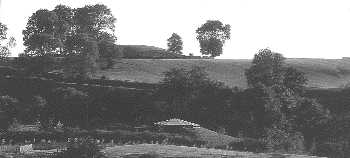
Picture of Navan Fort.
They journeyed from Navan Fort to Mullagh and there held council about the rebels.Dala from Ath Cliath (Dublin) came close to the gate of Mullagh and insulted them. Ethan ran forward returning the insult and rammed a hard apple into Dala’s mouth, breaking his teeth and he staggered away in pain, then collapsed with the apple still stuck in his jaws. Tephi went after Dala with some sherry wine to tend his hurt and met with Lughaidh, the missing, presumed dead, son of Ith Cian of Spain who had previously recently adopted Teia Tephi as his daughter, during her stay with him in Spain. After establishing each-others’ identity, Lughaidh swore allegiance to his step sister queen (Tephi). Tephi told him of the concern Ith Cian held about his welfare and that Lughaidh must contact him to tell him he’s alright.
Lughaidh took Tephi South to visit his camp in Bregia and introduced her to his men. Lughaidh’s force split and some followed him to join Tephi whilst the others left to join the rebels. Therefore they later decided to go North again to see Nuadh and tell him of their new allies.
On their journey to visit Nuadh they met up with Ith Cian, who had received word from Bregia that his son, Lughaidh was alive and well, and living in Ireland. Upon hearing the news Ith came straight to Ireland to visit his long lost son. When they met up and were reunited, they told him that a rebellion led by Bressail was happening against Teia Tephi and The Torah, so Ith set off back to Spain to gather his army to return with it and defend Tephi.
On the way to Howth, from where he was to set sail back to Spain he was attacked by three men of Tyre - Tyrians (known in Irish legend as the sons of Turenn - Tyrians) whom he had previously driven out of Eber (Spain). They stoned him to death and buried him under a pile of stones in a place now called Cian aneus Mor (Ceanannus Mor - Kells) which means Great Cian from the South (the king of Spain). Spain was also known as the Sunlands of the South. Later Lughaidh found out what had become of his dad; tracked down and slew the three men who had killed him, then buried them under the same stones that they had killed and buried Ith Cian under.

Columba's House, in Kells; built upon Ith Cian's grave mound.
Teia Tephi, Eochaidh and Lughaidh arrived at Navan Fort (in Co. Armagh) and Lughaidh played a joke on the guards where Nuadh, king of Ulster lived. Later they began to gather their alliance together to defend Teia Tephi and God’s Laws against Bressail and the rebels, who were plotting to destroy them all. They sent a message across the land to gather the righteous and God-fearing to join them, then Tephi returned to Mullagh, in, what was then, her province of Teffia, where she heard of the many fomorian (pirate) ships bringing Bressail’s rebels to Ireland from Wales, to fight for Bressail. There were so many ships that they almost looked like a bridge. Teia Tephi then sent a message to Elatha of Cornwall to tell him of his son, Bres’ evil acts, so Elatha sent his ships to put a stop to the fomorians and limit the income of rebels, many of whom left Ireland and returned back to their homes for fear of Elatha.It was decided that the battle would be held at the Ford of Unna (meaning destruction - probably in or near Slane), and they assembled their forces to prepare the battleground, five days before the 31st of October 583 B.C., when the battle had been set to commence. On the 16th there was a Lunar Eclipse in the Constellation of Taurus; the astronomical Zodiac Constellation represented by the bull symbol; during which time the moon would have looked blood-red and would have been seen as an omen of death and defeat by the Baal-worshippers, whose symbol is also a bull.
In the early stages of the battle Ethan, the king’s harper, who was love-sick and melancholy over Teia Tephi, ran forward unarmoured, to take-out Bressail, first with a spear and then his sword, but his sword broke on Bressail’s breast-plate and Bres knocked Ethan to the ground, but then protected him by laying his shield over him. Bennan sneeked in and stabbed Ethan under Bres’ shield with his spear, so Teia Tephi, seeing this, sent Aci to seek justice for the death of Ethan. Other losses were of Nuadh, who was slain by his old enemy Balor, who himself was later killed by Lughaidh, and Ogma and Indech who rode against each other and simultaneously killed each other with their spears.
Because Teia Tephi’s army was fighting for God and His Laws, they defeated the rebels with ease, even though they were greatly outnumbered, as Ith Cian had been murdered and so had not returned with his army. Five thousand and sixty-three were killed on the side of Bressail, including forty-two kings and many captains of hundreds; after which Tephi took Eochaidh’s white horse and bravely rode out, alone, up to the enemy’s line, carrying her golden trident. She offered to accept the opposers’ surrender. Bressail knowing that he was beaten, surrendered and swore allegiance to Teia Tephi. She then ordered him to help Lughaidh clear the seas of Fomorians (pirates).
From Tephi’s side the casualties were relatively few, only sixteen hundred and five in total, which was less than a third of the number of slain from the side of Bressail; the Baal worshippers and opposers. Teia became the legendary War-queen of Ireland, with her Olive sprig and Trident, because of her prowess and success on the battle-field; some even thinking she could have won single-handedly through magic. Unfortunately, from this latter belief, she was later wrongfully deified as the mythical goddess Bo / Bovinda and once having entered the realms of myth and fantasy she became lost to history as the real-life flesh and blood queen that she really was.
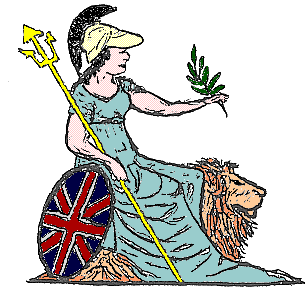
Picture of Tephi with trident.
To try to prevent this blasphemous deification, which had already begun whilst she was still alive, Teia Tephi told the Irish people to hold, near her palace at Teltown, close to Kells; every year; "Funeral Games" on the anniversary of her death (to prove that she was human and not a goddess). She died on the Calends (first) of August. These games had special rules based on The Torah, to commemorate and remember, both her and The Torah (God's Law), to make the people keep only God's Law as He commanded His people Israel (Deuteronomy 4:2; 17:14-20), in order to prevent her descendants; and others from making-up their own laws and the people thereby returning to poverty; division; strife and war. These "Funeral Games" were referred to by the sixteenth century French Prophet Nostradamus, in code, as the "Hecatombe Games", in his Quatrain 10,74, as explained in the booklet I have written about Kells and Teltown.After the Battle of Unna, in which the Baal-worshippers were defeated, peace was finally brought to Ireland because The Torah was fully instituted as National Law. The people of rank who died in the battle of Unna were buried in the mound of Knowth and those of lower rank were buried in the many satellite graves and burial mounds around Knowth. and throughout the Boyne Valley. It was from these many burial mounds that the battle became known as the Second Battle of Moytura, or, more correctly, the Battle of the Second Moytura (Plain of Towers).
At Tara, Teia Tephi’s judgment place, she was attacked with a poison blade by Cethlenn, the widow of Balor whom Lughaidh had killed in the battle. Eochaidh was swift to defend Teia Tephi from her attacker, but the poison blade fell from Cethlenn’s hand and wounded Eochaidh in the foot, from which wound he almost died. He never fully recovered from this wound and it made him forever limp as he walked, causing him to be wrongfully deified as the Daighda, the god in pain.
Jeremiah landed in Ireland with The Ark of The Covenant and it was placed, along with a number of other significant artifacts including David’s harp, which features as the Irish national emblem, in a specially constructed subterranean Grand Mergech (Mergech is not an Irish word but is a Hebrew word for a secret treasure store), according to the Irish Metrical Dindsenchas, beneath The Mound of The Hostages, at The Hill of Tara. The Mergech, which was also designed to be Teia Tephi’s tomb, was then sealed up, until the death of Teia Tephi on the Calends (first) of August of 534 B.C., after which her body was then also placed in the Mergech / tomb. It was re-sealed and has remained untouched since then.
In various Irish historical writings, the Tomb of Teia Tephi is said to be North-East of the Forrad; South of the Rath of the Synods and under a mound that measures 62 feet by 62 feet; as a circle of that diameter does. Summarising all of the writings, the only place that can possibly be is under The Mound of The Hostages, at the Hill of Tara.Legend has it, that Jeremiah landed at Carrickfergus in Northern Ireland and brought The Ark across country to Tara, in Royal Meath, from there.
Once The Ark was safely sealed in Teia Tephi’s future tomb, Jeremiah’s mission for God was complete and he died on the 21st of September in 581 B.C. He was buried in what is now called Cairn T at the Loughcrew Hills graveyard. Depicted in hieroglyphics on the second stone on the left as you enter Cairn T is the journey Jeremiah made from Jerusalem to Ireland. The hieroglyphics, or sacred tymboglyphics as Sir William Wilde called them, also show astronomical data from which the date of Jeremiah’s death, as well as the date of the Lunar Eclipse that occurred just before the Battle of Unna was fought, can be calculated.
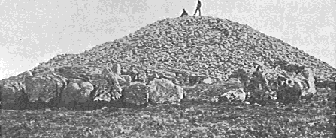
Picture of Cairn T.
The people never forgot Bressail’s selfishness; evil and arrogance, so when he died he was buried in a tomb that was made to face the setting sun, rather than the sunrise and his grave was named Dowth, which is derived from the ancient Gaelic word Dubad meaning darkness.Teia Tephi had a palace built at Teltown. (near Kells), where she lived with Eochaidh and had four children named Aedh, Ainge, Aengus and Cermad.

Map showing Teltown and other related sites.
Aedh, her firstborn son, became evil because Teia Tephi loved him (emotionally) more than she loved God or her people and didn’t discipline him correctly to The Torah. God took Aedh from Teia Tephi as a punishment to her and so that he would not grow up to become an evil king over the Irish people and destroy the kingdom she had built up. Aedh died whilst still a teenager and his body was placed in the eastern side of Teamur (Tephi’s Wailing Wall - now known as The Mound of The Hostages) at Tara, so she could weep over his grave while she wept over the fall of Jerusalem.In 1955 the Irish archaeologist Sean P. O’Riordhain found Aedh’s skeleton, still wearing Egyptian beads that had been given to his mother Teia Tephi, by pharaoh Hophra, when he adopted Tephi as his own daughter during her stay in Egypt, before she came to Ireland to be its queen.
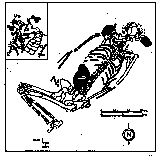
Picture of Aedh’s Skeleton.
Tephi’s second born was a girl named Ainge who grew up to marry Nuadh’s grand-son, Ethdan, who was selfish and became the chief of the Miledh (Warriors; Milesians; [Milites - sons of Mil]) after Lughaidh passed away.Her third child was a son she named Aengus, who was brought up by Eochaidh’s sister, Maistiv in Mullagh, Co. Cavan. Because Teia’s first born Aedh died in his teens, Aengus succeeded his parents to the Throne, but grew up to be arrogant and worshipped gold, rather than God. He had the grandest tomb in Ireland constructed for himself to become immortal in, when the Winter Solstice sunrise entered his tomb. Part of his wish was accomplished, by his being immortalised in human memory for his magnificent tomb at Newgrange, which is confirmed by the hieroglyphics "written in stone" on Stone C4 in the West Recess inside of Newgrange, where his name Aengus is written in Ogham Script.
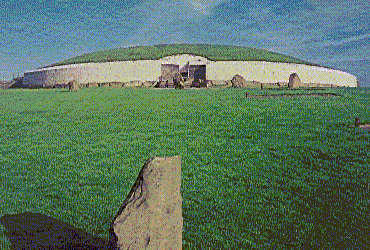
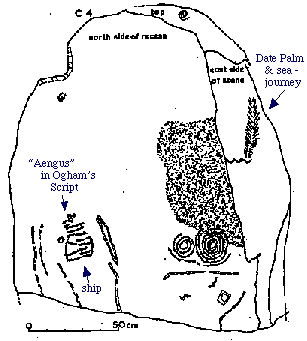
Pictures of Newgrange and Stone C4.
Not much is known about Cermad, Teia Tephi’s youngest son.The Lia Fail Stone that Teia Tephi brought with her from Jerusalem stayed in Ireland, on the Forrad (Inauguration Mound), at Tara, for more than a thousand years and all of the Irish kings were crowned upon the Stone up to c. 500 A.D.
It was then loaned to Fergus, the brother of Muircheartach (Murdoch) king of Ireland, who had emigrated to Scotland and wanted to be crowned king of the Irish who had settled there and had become Scottish.
The Stone was not returned to Tara and stayed in Scotland, where it was called the Stone of Destiny (English for Lia Fail) and all of the Scottish kings were crowned upon it, until 1296 A.D. when Edward the first of England "Longshanks" invaded Scotland; defeated the Scots and took the Stone, from Scone Abbey near Perth, to London where all of the English kings were subsequently crowned in Westminster Abbey upon the Stone of Destiny, up to, and including, George the Sixth.
In 1950 four Scottish Nationalists removed the Stone from Westminster Abbey; took it back to Scotland and a fake stone called the Stone of Scone was later placed at Arbroath and from there it was taken to London. It was this same fake stone that Elizabeth the Second was crowned upon in 1953, so in actual fact, she has never really officially been crowned queen of the British people in the eyes of God.
All of the Irish; Scottish and English monarchs after 583 B.C., including Elizabeth the Second, are descended from Eochaidh and Teia Tephi of the line of David from the tribe of Judah. The Stone was taken in 1950 from the House of Windsor from the line of David in fulfillment of God’s Prophecies in The Bible Book of Genesis chapter 49:10 - "The sceptre shall not depart from Judah (the line of David), nor a law-giver from between his feet, until Shiloh (Christ) comes" (and then it will depart from Judah to the line of Joseph. That is its destiny, preordained by God and is why, since it was first removed from Bethel by the Israelites and carried through the wilderness on a pole for forty years with Moses, it has always been known as the Stone of Destiny). Ireland, is known as Inis Fail, meaning, the Island of Destiny.
Teia Tephi left many prophecies in her autobiography, most of which have been fulfilled in exact and minute detail. The most important one is yet to be fulfilled and it states that she will, one day very soon (according to Nostradamus), be recovered from her tomb at The Hill of Tara and The Torah contained in The Ark of The Covenant will once again be re-instituted, bringing peace and prosperity to all of Ireland (North and South), with the simultaneous inauguration of Christ, during the Second Coming, as King of the faithful of Israel upon the real Bethel / Lia Fail / Stone of Destiny on the Inauguration Mound at the Hill of Tara, on the Island of Destiny.
Another point of amazing significance is that, at the beginning of chapter 31 of her Book, Teia Tephi prophesied that the last overturn of the Throne, to Christ, would happen on the 2,484th anniversary of her death, in 534 B.C., which coincides perfectly with 1950 when four brave Scottish Nationalists removed the Stone of Destiny from Westminster Abbey, for God, so that Elizabeth could not be crowned whilst Christ the King is on the Earth*. All that remains now is for The Ark to be recovered** and Christ to be Inaugurated at Tara on the Stone of Destiny.
Now you’ve read the story; you should also read the Book.
For Teia Tephi’s life in much more detail and in rhyme, just like the Irish Metrical Dindsenchas, please send for a copy of "The Book of Tephi Queen of Tara and Gibraltar". Please see below for detalils of how to get your copy.
Tephi's Book was restored; translated into English and originally published in 1897 and it has been edited by and has had explanatory notes added by me - JAH.
Elizabeth the Second, who like her forebears has made-up her own laws, illegally, against God's command, is descended from Tephi and Eochaidh. The word Brit-ish is Hebrew not English and it means "the People of The Covenant - Israel" and the Ulster flag shows Zarah's "Red Hand", surrounded by Israel's "Star of David", superimposed on the Cross of Sacrifice. The British coat-of-arms has David's Harp (which is also the National Symbol of Ireland); the Lion and the Unicorn, which are all heraldic "Signs of Israel" (Num. 24:8-9), and, exactly as Tephi said in 2 (2) below, are "'Signs' that be left to show"*** - the British, U.S.A. and IRISH their TRUE identity. (Please study my "The Four Horsemen of the Apocalypse and the Two Witnesses" Booklet, for more details).
*** Christ's own personal flag is the Union Jack flag, as explained in Genesis 49:10, where it says clearly, that, "unto him (Christ / Shiloh) shall the gathering (Union) of the people (of Jack-ob/Israel) be."
The "Book of Tephi" was then carefully preserved for 2,500 years by The Ruler of The Universe, safely, in Ireland, for The Day of The Revealing (Sura 52:1) and for the removal of Israel's Blindness (Isaiah 42:19) [the U.K. & U.S.A. - see 2 (2) below], to their true identity. The House of Israel (the 10 "lost" tribes) alone was blind; the House of Judah - the Jews (2 tribes) have never been blind to their identity, even though they claim to be Israel, when they are NOT (for a detailed explanation of this fact and the TRUE identity of the Gibraltarians please study carefully my "Gibraltar - British or Spanish" Booklet and also the FACTS contained in this Book.
The Book of Tephi: "2:2 Nay, Joseph (Ephraim and Manasseh - Israel: Gen. 48:16) shall long be blind,
An ox (unicorn) that sleepeth at "midnight", and Judah couched (Gen. 49:9) as a hind.
The lion hath fled from his lair. The ox (unicorn - Deut. 33:17) hath wandered astray
Till the dawn of the East be red, and the night of the North be grey,
In the "Night" shall no man know them, or the "Signs" that be left [them] to show
Where the Shepherd keepeth the ox (unicorn), whilst the lion is couched full low.
Not by the banks of Jordan, NOT on the Holy Hill [but in Engelland - see 11 (3)]
Are Ephraim's feet, until his furrows be ploughed unto Yahweh's (God's) Will.
Bethlehem's field is empty. The Shepherd (Messiah) follows astray.
Hear ye my words, oh my sons, for "the isles (Brit-ish)" shall await "The Day".
Tephi, I was but weak, a little thing in men's eyes,
A "tender twig of the Cedar", yet sheltered by Prophecies (Eze. 17:22).
The Prophet of God revealed this. Is not His Word made plain?
He came to "root and destroy". He went forth to "plant again" (Jer. 1:10)."* My Booklet titled "On The Way to Emmaus Again", explains in minute detail, the prophesied place and exact timing of the Second Coming.
** Only one obstacle remains preventing the recovery of the Ark of the Covenant, and the fulfillment of the remaining prophecies. Click HERE to find out how you can help remove this obstacle, and bring this story to it's dramatic & wonderful climax.
Many people will say, or think, that this is an amazing story; which, of course it is, but the most amazing thing of all, about this story, is that it is TRUE. So, keep the tidal wave going, and, please download and send this amazing story far & wide to EVERYONE that you know!!
Peace be upon you,
JAH
There is a series of booklets relating to this, that can be downloaded for free from my website, which you may have already discovered by clicking on the hyperlinks in this document, but for those of you who would like any of these booklets in hard copy paper-back booklets to read as a normal booklet they can be obtained by mail order from the address below. This is not about selling booklets and they have been priced accordingly, just to cover our costs.
If you are not interested stop here. But for those of you who are, please send for the list.
The hard copy of "The Book of Tephi, queen of Tara and Gibraltar" is no longer available in print, but is available in colour in pdf format on CD, for which you can send £10 Sterling (U.K.) or $20 U.S (rest of the world) (incl. p&p) to:-
JAH, JAH Publications, P. O. Box 2129, Canvey Island, SS8 9UF, England, U.K.
![]()
|
|
|
|
|
|
|
|
|
|
|
|
|
|
|
|
|
|